Redwoods and Climate Part 2
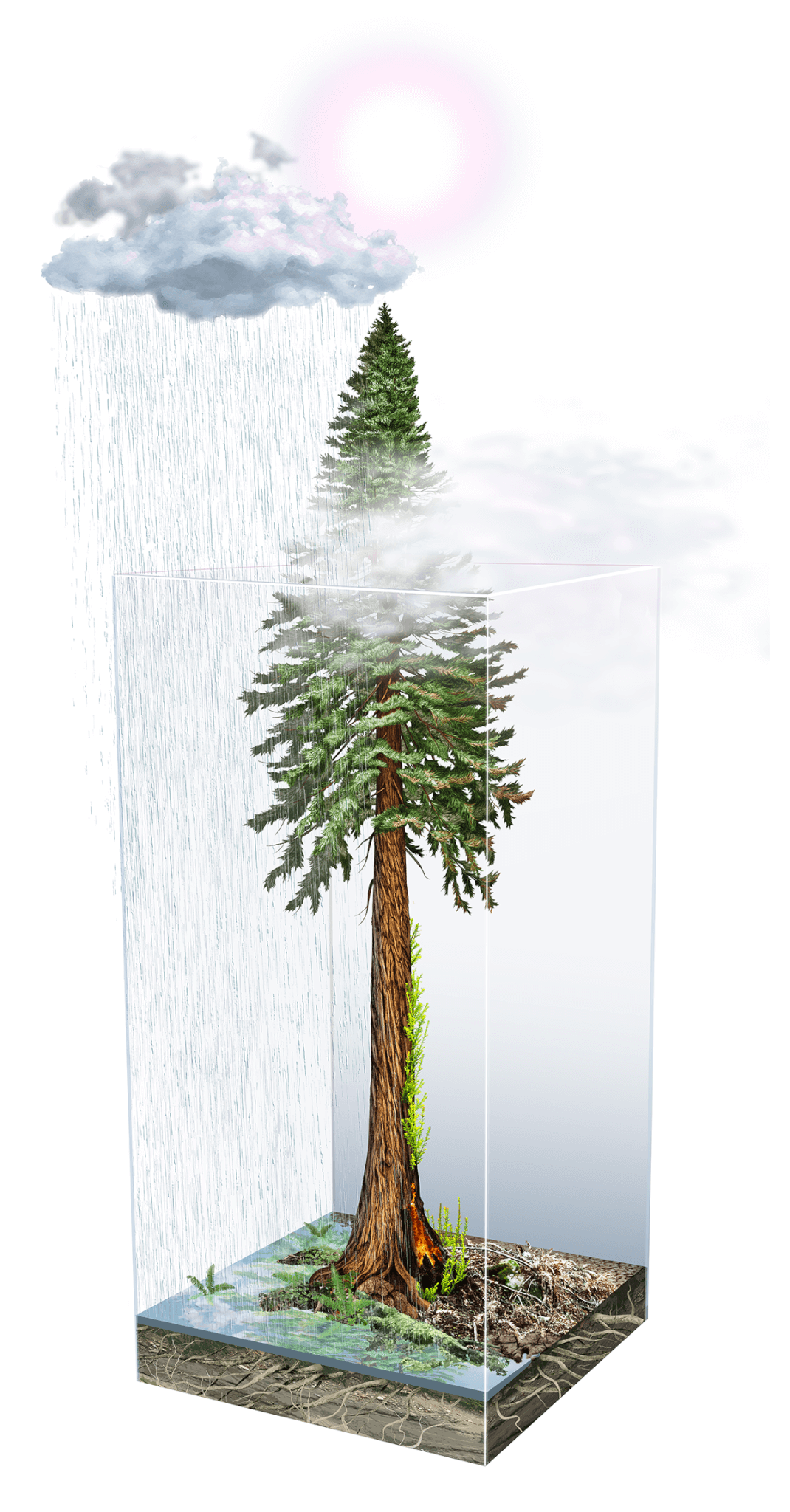
Impact of climate on redwoods by Ink Dwell studio
The Impacts of Climate on Redwoods: Part 2
Cut by deep valleys, cooled by the sea breeze, and draped in fog, the Santa Cruz mountains are a southern stronghold for California’s coast redwoods. The range’s oldest trees have withstood nearly two millennia of drought, floods, winds, fires, earthquakes, and changes made by the area’s human residents.
In the second part of this new series by Julia Busiek, Sempervirens Fund explores how Earth’s constantly changing climate shaped redwoods over millions of years, how human-caused climate change is affecting redwoods today, and what the future holds for the iconic forests of the Santa Cruz mountains.
What Redwoods Tell Us About Climate, and Water
As anyone who’s ever stuck their face up close to a cut log knows, trees growing outside of tropical latitudes all have distinct annual growth rings. During summer, when the days are long and the growing is good, trees add wood to their trunks more rapidly than in the winter, when—in many climates—growth all but stops. These alternating cycles of growth and stasis show up as concentric rings on the cut surface of a stump, and since the late 1800s, a branch of science called dendrochronology has studied these rings for information about the climate conditions that prevailed as the tree grew each one, and how those conditions changed over the tree’s lifetime. In a drought year, trees grow less, and make skinnier rings, compared to years with plentiful rainfall.
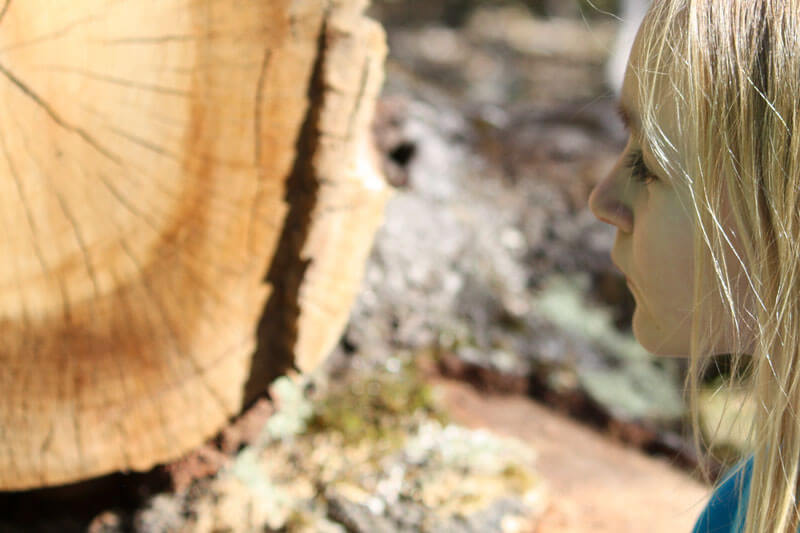
“It’s like a record back in time,” says Allyson Carroll, a dendrochronologist who studies redwoods at Cal Poly Humboldt. The older the tree, and the more its wood resists rot, the further back a dendrochronologist can see, either by cutting a round from a stump or a downed tree, or extracting a pencil-thin sample from the bark into the oldest heartwood using a borer. “For old trees with decay-resistant heartwood—like coast redwoods—that material stays intact for a long time. So, you have the potential for annually resolved climate records going back centuries,” Carroll says.
Emphasis there on potential: “Certain things about coast redwood are just confounding for dendrochronologists,” says Carroll. Some rings go missing from the trunk entirely. Others “pinch out,” appearing on one side of the trunk but tapering to a wedge and disappearing on the other. “I don’t know why it occurs, but it’s much more common for coast redwoods than for many other species,” Carroll says. And that’s just the noise in the signal from a single tree. In addition to climate effects, “That tree is also experiencing other things. It could be suppressed for a number of years by a neighboring tree, then the neighboring tree falls, or a branch breaks off, or a fire goes through,” Carroll says. The trick to gleaning climate data from redwood rings is to compare multiple samples from a single tree, multiple trees from a single stand, and multiple stands across the range.
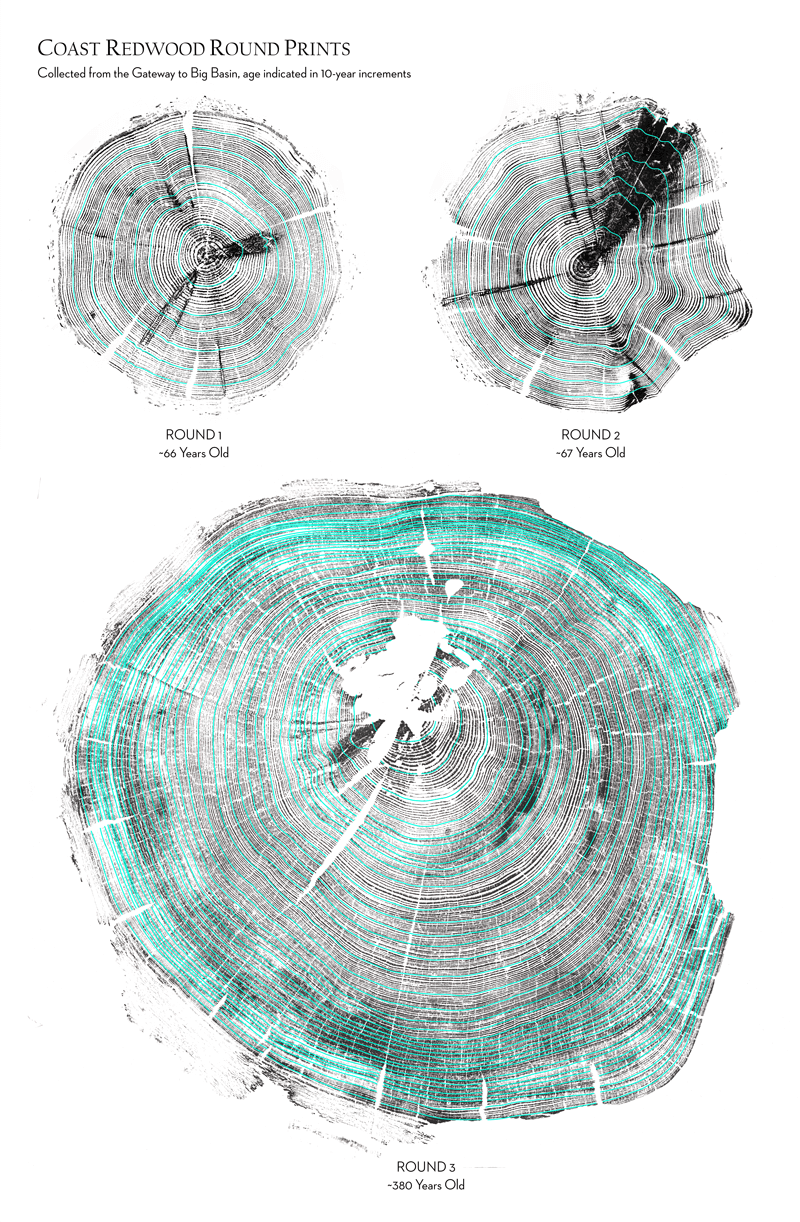
The goal of all these comparisons is to “cross-date” a tree’s rings, or assign an accurate date calendar year to each by matching patterns of wide and narrow rings that show up in multiple trees across the landscape. By now, Carroll can size up a core sample and quickly clock the position of what she calls “marker years,” where especially severe climate conditions show up consistently in trees across the site or range. She can name California marker years like she’s rattling off her phone number: “If I just took a core, I’d go, OK, 1983, bigger. ‘77 smaller, ‘59 smaller, ‘36 probably bigger with thick latewood, ’24 smaller.” By cross-dating multiple trees from a single area, Carroll can generate so-called reference chronologies, “where you essentially collapse all that information into a single time series.” She says researchers completed a multi-millennial reference chronology for coast redwoods’ closest living relative, the giant sequoia, back in the early 1900s. But owing to redwoods’ convoluted growth patterns, which researchers have variously described as “erratic,” “esoteric,” and “one of the worst species to work on,” few dendrochronologists have been able to crack their chronological code.
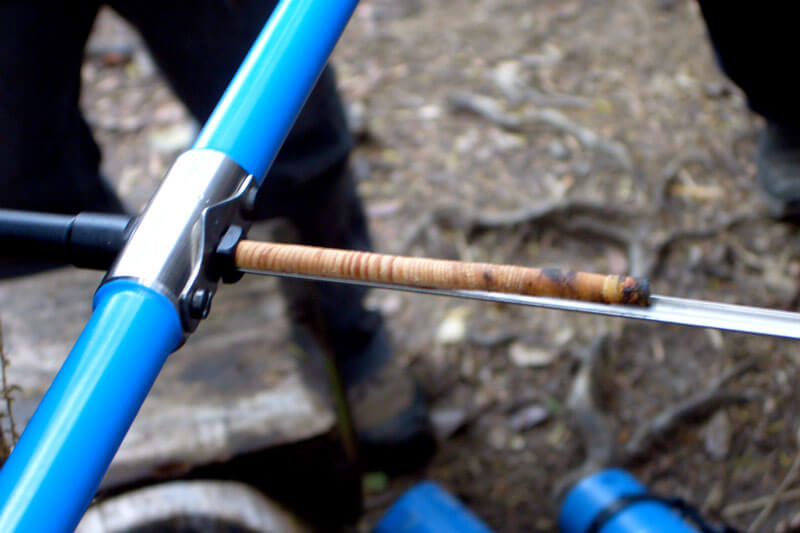
Carroll, however, relishes a challenge. In a forthcoming paper she’s co-authoring with her Cal Poly Humboldt colleague Steve Sillett, reference chronologies will be published from 45 redwood forests distributed from north to south and coast to inland across the species’ present-day range. The longest chronology of the set dates all the way back to the year 328 CE, while a sample from one of the five sites in the Santa Cruz mountains goes back to about 705 CE. To collect all these data, researchers climbed at least five trees at each location, collecting core samples at regular intervals so they could detect rings that might have wedged out in one portion of the trunk, possibly to reappear at another. Back in the lab, Carroll measured each ring to the micron (one-thousandth of a millimeter), then combined all the measurements into a standardized index that other researchers can use to more accurately date redwood trunks from anywhere in the range.
“It’s cool because these reference chronologies can help advance so many different research goals,” she says—from dating fires or earthquakes to picking out oscillations in rainfall and temperature over millennia.
Performance Reviews for Redwoods
Carroll and her colleague Steve Sillett are already putting these reference chronologies to use to better understand how climate change is affecting redwoods right now. Alongside three co-authors, the researchers are getting ready to submit an article that incorporates these cross-dated series into a range-wide analysis of what Sillett calls “performance characteristics”: in any given forest, how long does it take a Sequoia tree to grow to a certain size, and how much biomass can it produce annually at that size? “And since the climate is changing rapidly, we’re more and more interested in how redwoods are responding to changing conditions,” Sillett says.
The hard part—if you don’t count swinging around on a rope hundreds of feet above the forest floor, extracting long, delicate core samples from each of more than 235 different trees across 45 locations—is isolating which climatic variable is most responsible for the growth patterns the researchers have observed. “You could plot, say, tree growth versus the stock market, or tree growth versus carbon in the atmosphere, or annual average temperature, or human population size. They’re all strongly correlated because they’re all increasing over time,” Sillett says. Which variable, or combination of variables, is causing changes now, and likeliest to keep causing changes in the future?
Sillett’s team has quantified changes in redwoods’ performance characteristics that are linked to an already-changing climate. Since the 1960s, trees from the Santa Cruz mountains to the California-Oregon border have been growing faster than at any time in the preceding centuries. Sillett reckons some of this growth spurt is attributable to fire suppression—after a redwood tree loses lots of leaves in a fire, it tends to spend the next several years regrowing its crown. That means it doesn’t have much energy to spare getting larger overall, so it might not make any growth rings in its trunk for a few years following a fire.
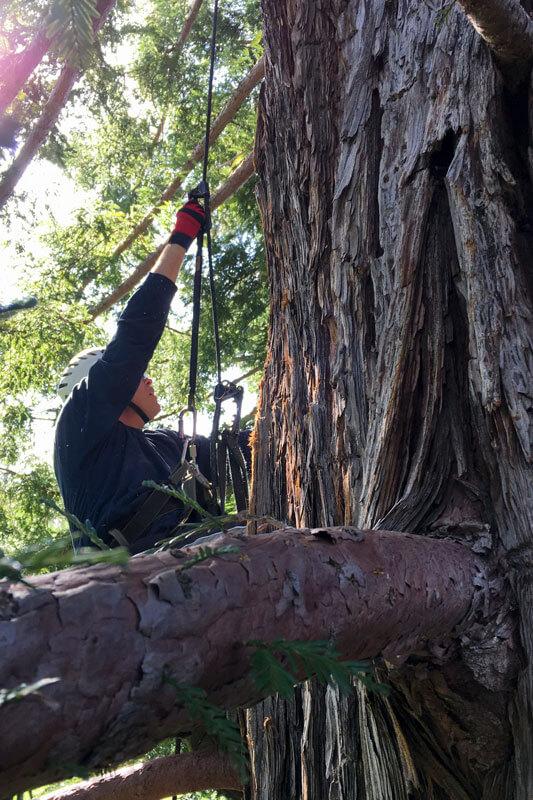
Take the fire out of the landscape—as we’ve done to increasingly disastrous effect for over a century—and you knock down one growth constraint, at least for the oldest, hardiest trees. “I think that’s why we see some old trees out there right now are just kicking ass and taking names —they have enormous, leafy crowns.” Sillett says. He also suspects that the sharp increase in atmospheric carbon dioxide since about 1960 is supercharging photosynthesis and increasing water-use efficiency, at least for trees in the cooler, wetter heart of the range north of San Francisco.
That’s not to say less fire or more carbon dioxide is good for California’s redwoods in the long run, however. “If we see increasing drought going forward with increasing temperatures, it doesn’t matter how much CO2 they have. Without ample water, they won’t be able to sustain the same growth rates,” says Anthony Ambrose, a redwood ecologist with the forest research nonprofit the Marmot Society. To some extent, that prediction is already playing out: Redwood forests in Big Sur and Napa, on the southern and eastern edges of the range, grow in hotter, drier terrain. They’re not necessarily less healthy, but they’re smaller and patchier than their relatives in Humboldt County, or even the Santa Cruz mountains. “It’s just a different kind of forest,” Ambrose says. Notably, the forests growing on the range’s southern and eastern margins haven’t enjoyed a carbon-fueled growth spurt like their counterparts further west and north, owing to limited water availability: “Water is this species’ Achilles’ heel,” Ambrose says.
The forests on the fringes of the redwood range have the most to tell us about how the species will fare in a hotter, drier future.
So, it’s these forests on the fringes of the redwood range that have the most to tell us about how the species will fare in a hotter, drier future. “It turns out that redwoods [in the wetter parts of the range] are not very responsive to climate,” Sillett says. “Year in, year out, they’re doing their thing. If their roots are wet, everything’s good for them.” Climate scientists call redwoods in the heart of the range “complacent,” compared to those that grow on the margins. The more resources—light, water, nutrients, CO2—the tree has access to, the more muted its response will be to short-term climate anomalies. Even as the region’s temperatures have risen by 2° F in just the past 50 years, Sillett’s data show that, based on their performance since 1901, redwoods in unlogged forests of the Santa Cruz mountains grew faster than expected for their size during the 21st century, at least until the drought from 2012 to 2016. One previously logged forest Sillett studied in the Forest of Nisene-Marks State Park had redwoods up to 287 feet tall and only 130 years old. “In terms of height, these are the fastest-growing redwoods in the entire range,” Sillett says. “Nothing up north comes close.”
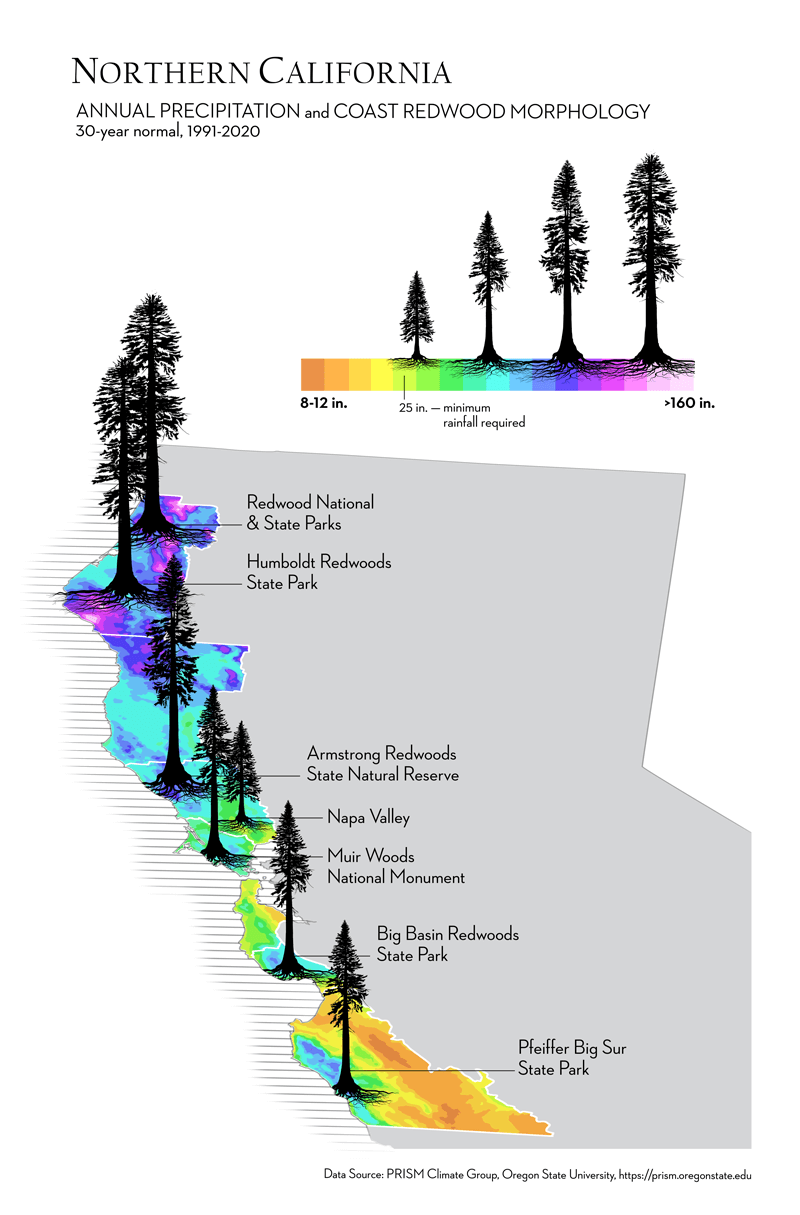
So, where’s the transition between the water-stressed trees of Big Sur and the complacent giants of Humboldt County? Right now anyway, it hews roughly to the southern end of the Santa Cruz mountains, at about 37 degrees latitude. South of that, trees get shorter and forests patchier “pretty rapidly,” Sillett says (though he has found trees growing along spring-fed streams in Big Sur that have shown more muted responses to drought than trees growing in drier, more marginal sites further north). As temperatures rise and if droughts get more severe, “we will see more problems” for redwoods between Santa Cruz and Pacifica, Sillett says. But these big mountains still generally catch and collect enough moisture to keep creeks running year-round, and their deep valleys stay cool and shady, helping slow trees’ water loss on hotter days. “At present, the Santa Cruz mountains are near the southern edge of a moving front,” Sillett says. “But in terms of water availability, for now, things aren’t as bad for them as you might imagine.”
Of course, water and temperature are just two strands in the interwoven web of variables that determine the fate of a tree, a forest, or a whole species. The climate affects the frequency and intensity of wildfires, for instance. Redwoods can withstand fires better than most of the other tree species in the Santa Cruz mountains—the 2020 CZU complex fires killed 85 percent of the range’s mature Douglas-fir and 29 percent of its madrones, while 95 percent of redwoods survived. That fire’s intensity was alarming, Sillett says, but to a certain extent, more frequent fires could give redwoods a new edge in the region: “Given their extreme resistance to fire and prolific cloning, Sequoia could gain market share in the Santa Cruz mountains with proper management,” Sillett says.
Preparing Redwoods for Climate Change
So, what, if anything, can we do to prepare the Santa Cruz mountains’ redwoods for climate change? Individuals, and even local and state governments, can’t do much on their own to curb worldwide carbon emissions or keep global warming under the 1.5°C target set by the Paris Climate Accords. But Sempervirens Fund is part of a network of local land managers that’s thinking pretty big when it comes to managing the region’s ecosystems for a hotter future. In a report published last year, the Santa Cruz Mountains Stewardship Network got together a list of management strategies that could help each of the area’s habitats, including redwood forests, adapt to higher temperatures, stronger storms, and more frequent fires. Some strategies suggested in the report, like irrigating selected “high-value” redwood stands or genetically engineering more drought-tolerant trees, have yet to make an appearance in the region. But many other climate resilience strategies are already in play around the region, says Laura McLendon, director of land conservation for Sempervirens Fund.
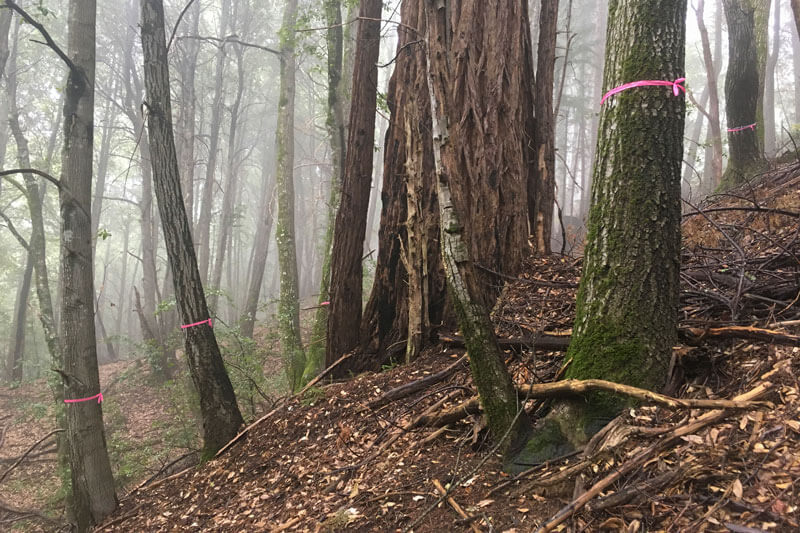
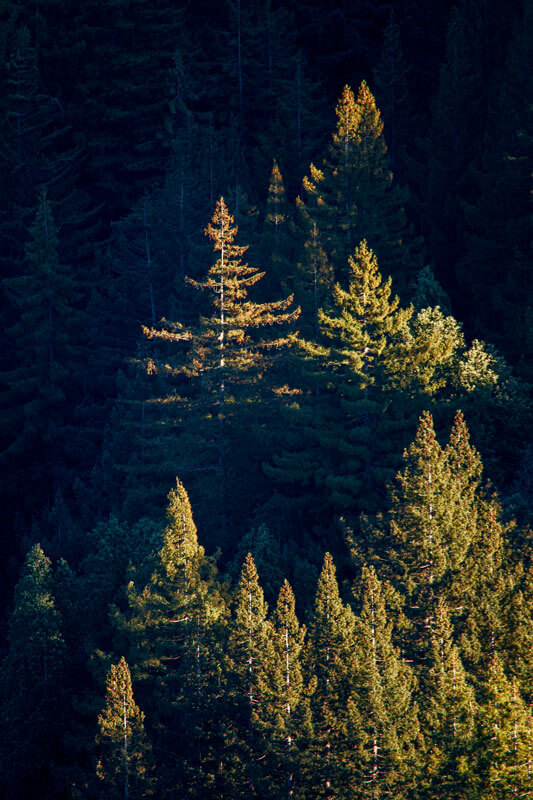
At places like San Vicente Redwoods, foresters are selectively cutting smaller trees and thinning the understory, aiming to help the biggest trees in previously logged stands grow faster. Thanks in part to research from scientists like Allyson Carroll and Steve Sillett, “we know bigger, older redwoods are more resilient to disturbance from catastrophic wildfire, storms, floods, disease, you name it,” McLendon says. “So, the quicker you can return second-growth forests to certain old-growth characteristics like wider spacing and fewer stems per acre, the better.” The goal is less to return the forest to some specific prior state, and more about knocking down some of the ecological hurdles left by over a century’s worth of logging, road building, fire suppression, and development. “You can’t really restore the land to what it was in the past, given that we know the climate isn’t going to be the same as it was 150 or 200 years ago,” she says. But by restoring and actively managing ecosystems throughout the Santa Cruz mountains—at a much bigger scale than we’re currently accustomed to—we can give redwood forests a better shot at withstanding the climate chaos to come.
By looking deep into the history of redwoods and climate, scientists have sharpened our understanding of how the forest might respond to the changes to come. But every new finding about these ancient interrelationships reveals another layer of complexity. “Our challenge now is to balance the best available science with action,” says McLendon. She and her colleagues will keep integrating new information into the way they prioritize what lands to protect, and how they manage the forests under their stewardship. But the important thing is to act fast, and do it at a scale that approximates the changes that are already underway. “Climate change is such an existential threat—to everything, but especially the natural world,” McLendon says. “We’ve got to shore up these ecosystems and make them as strong and resilient as possible, as soon as possible.”
More to Explore
- Read Clues About Climate's Future from Redwoods' Past in Part 1 of Redwoods and Climate
- Learn more about How Research Looks Deep into the Past for Clues to Climate’s Future with Jason Addison, USGS, Under the Redwoods
- Read more about how Coast Redwoods Are Our Greatest Ally in a Changing Climate
- Read our Top 10 Facts about Coast Redwoods and climb through the stories of a redwood tree

